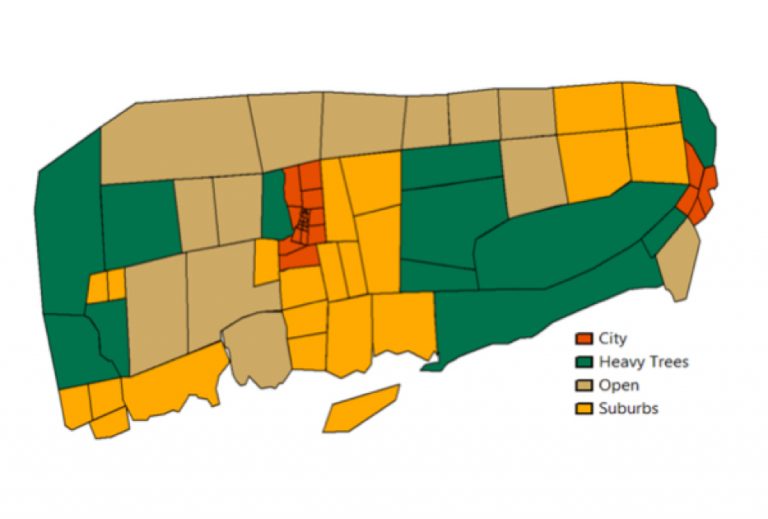In the wake of a disaster, access to roads, power, water supplies and other publicly managed utilities are important to the recovery process. But where do commercial services that provide access to food, medications, fuel and banking fit into community’s concept of post-disaster resiliency?
Coastal Resilience Center of Excellence (CRC) Principal Investigator Dr. William “Al” Wallace of Rensselaer Polytechnic University (RPI) is considering this question through his project “COmmunity SUpply REsiliency (COMSURE).” The project focuses on the degree to which critical services can be maintained during an event or restored in its aftermath. Researchers on the project include Dr. John Mitchell, Dr. Thomas Sharkey and Richard Little, all of RPI.

The objective of the research is to better understand, describe and portray the supply chains that provide the goods and services needed to respond to and recover from an extreme event, such as a hurricane impacting a coastal community. The result will be GIS visualizations of supply chains for review by both providers of critical goods and emergency managers.
Researchers have collected data on critical commercial services and their interdependencies with civil infrastructure in New Hanover County, a coastal county in North Carolina that is home to more than 200,000 people. This information was used to create a dataset for CLARC, an artificial test community where researchers can simulate interruptions to delivery systems of critical commercial services based on expected infrastructure outages from a hypothetical storm event.
One example is the supply chain for distribution of gasoline, overlaid onto maps of a municipality. This supply chain will be integrated with others developed in past research. Dr. Wallace and team hope to, through the model, represent relationships between supply chains and support infrastructure such as power, communications and transportation. They hope to help emergency managers and those responsible for managing infrastructure be able to share information to determine the best mitigation and restoration strategies.
Dr. Wallace said one of the team’s major – but not unexpected – findings from the CLARC simulations using critical commercial service data was that those enterprises are subject to the same types of disruptions as healthcare, public safety and other social infrastructures.

“They all require power, water and sewer, communications and transportation to function,” Dr. Wallace said. “However, we did learn that the supply chain for prescription medications is unlike those for food, fuel and banking services because its products can’t be provided through self-organizing community networks.
“In an emergency, people can informally swap or trade in food and fuel if it’s available and even lend and borrow money but it’s both illegal and potentially life-threatening to for people to share prescription medications. Our emergency response and recovery planning typically does not take this into account.”
The COMSURE modeling tool will be incorporated into the existing MUNICIPAL tool that shows interdependencies between civil infrastructures and the delivery of critical services, including healthcare, emergency management and public safety.
MUNICIPAL focused on the restoration of critical infrastructure systems, including network models of social infrastructure systems, a damage assessment model and a disruption of services model.
The COMSURE tool is designed for local emergency managers and federal analysts interested in improving policies that affect community resilience to extreme events, Dr. Wallace said. If incorporated into university curricula for emergency management, he said it may also help a new generation of emergency managers to be more comfortable with computer-aided decision support tools for planning and training purposes.

The tool will also be made available to private sector service providers interested in improving the resilience of their supply chains.
“The tool will ultimately be available through DHS/FEMA for anyone to use as they see fit,” Dr. Wallace said. “The private sector could use it to identify vulnerabilities in their supply chains) and take corrective actions to reduce the vulnerabilities such as back-up generators or alternative suppliers.”
Previously, information about the role of critical commercial services in community resiliency was largely anecdotal, Dr. Wallace said. This is particularly true for the end-of-chain customer interactions that directly affect people.
“Private enterprises are a key element of community resilience, and the public emergency management operation needs to be aware of this.”
A better understanding of these complex interactions will assist emergency managers, utility service providers and other key decision makers in determining what assets should be hardened against damage and what should be the priorities for service restoration following an extreme event so that the most critical services are made available in the shortest possible time, he said.
“Private enterprises are a key element of community resilience, and the public emergency management operation needs to be aware of this, and consider some of them for priority restoration,” Dr. Wallace said. “This is particularly true for stores that serve areas that have a high percentage of vulnerable households such as the elderly, poor and disabled. These communities will tend to rely on local merchants and may lack the mobility to travel extra distances to secure what they need.”
